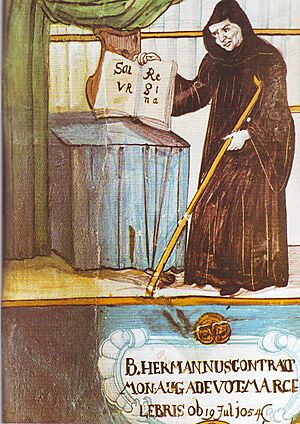Hermann of Reichenau facts for kids
Quick facts for kids BlessedHermann of Reichenau a.k.a. "Hermann the Cripple" O.S.B. |
|
|---|---|
 |
|
| Composer of the Salve Regina | |
| Born | 18 July 1013 Altshausen, Swabia |
| Died | September 24, 1054 (aged 41) on the island of Reichenau, Lake Constance |
| Honored in | Roman Catholic Church |
| Beatified | c. 1863 by Pope Pius IX |
| Attributes | holding a manuscript with the words "Salve Regina" Benedictine habit staff or crutch |
| Major works | Salve Regina Veni Sancte Spiritus Alma Redemptoris Mater |
Blessed Hermann of Reichenau (born July 18, 1013 – died September 24, 1054) was a very smart Benedictine monk and scholar from the 11th century. He was also known as Hermann the Cripple. He wrote many important works about history, music theory, mathematics, and astronomy. He also composed many hymns, which are religious songs. People often say he wrote famous hymns like "Salve Regina", "Veni Sancte Spiritus", and "Alma Redemptoris Mater". The Roman Catholic Church officially recognized him as "Blessed" in 1863.
Contents
About Hermann's Names
Hermann had a few different names. Sometimes his name is changed to "Herman" in English. In Latin, it might be "Hermannus".
He was sometimes called Hermann of Vöhringen because that was his birthplace. But he is best known as Hermann of Reichenau. This name comes from the Reichenau Island where his monastery was located.
He was also traditionally known as Hermannus Contractus in Latin. This means "Hermann the Lame" or "Hermann the Cripple" in English. This name described his physical condition.
His Early Life and Challenges
Hermann was born on July 18, 1013. He was the son of a Count from Altshausen. From a very young age, Hermann had a serious physical disability. He was born with a cleft palate and cerebral palsy. Some records also suggest he had spina bifida.
Because of his condition, he had great difficulty moving around. It was also very hard for him to speak clearly. When he was seven years old, his parents placed him in a Benedictine monastery. They could no longer care for him at home.
A Brilliant Scholar and Monk
Hermann grew up in the Abbey of Reichenau. This abbey was on an island in Lake Constance in Germany. The monks there taught him many things. He became very interested in both theology (the study of religion) and the world around him.
When he was twenty, Hermann became a Benedictine monk himself. He learned several languages, including Arabic, Greek, and Latin. He also studied and contributed to all four main subjects of learning at the time: arithmetic, geometry, astronomy, and music.
His Amazing Works
Hermann wrote many important books and papers. He wrote about history, mathematics, astronomy, and Christianity. One of his works was about the science of music. He also wrote several books on geometry and arithmetic.
He created astronomical guides, including instructions on how to build an astrolabe. An astrolabe was an old tool used to measure the positions of stars and planets. Because of this, some people even thought he invented the astrolabe.
As a historian, Hermann wrote a detailed chronicle. This book covered events from the birth of Christ up to his own time. His student, Berthold of Reichenau, later added more to this history.
Hermann was also a famous religious poet and musical composer. Some of his surviving works include music for religious services for St. Afra and St. Wolfgang. Later in his life, he became blind. This did not stop him, and he began writing hymns.
He was so well-known that later writers often gave him credit for compositions. Among the works traditionally said to be his are the famous hymns:
- Salve Regina ("Hail Queen")
- Veni Sancte Spiritus ("Come Holy Spirit")
- Alma Redemptoris Mater ("Nourishing Mother of the Redeemer")
Hermann died on Reichenau on September 24, 1054. He was 41 years old. The Roman Catholic Church officially recognized him as "Blessed" in 1863.
Legacy and Recognition
Hermann's work continued to inspire others long after his death. For example, three of the five symphonies written by the Russian composer Galina Ustvolskaya were based on his texts.
See also
 In Spanish: Hermann von Reichenau para niños
In Spanish: Hermann von Reichenau para niños
- List of Roman Catholic scientist-clerics


